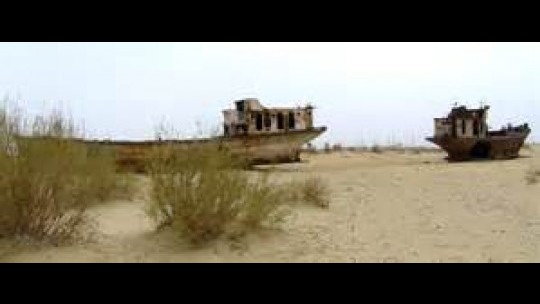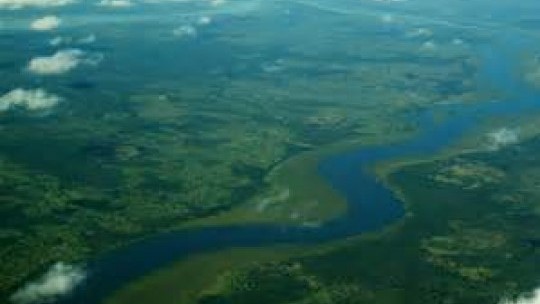Water - Pt. 1: More Precious than Gold
12:45 am, Thu July 30, 2015
By Bumpy Walker
A distant figure on a camel appears, growing larger and larger against the background of the endless flat desert and an infinite sky. Two men are resting at a well, watch the approaching figure. Suddenly one of the waiting men bolts to his resting camel and pulls a gun. He aims the weapon at the approaching figure. Before he can fire, a shot sounds and the gunman falls dead. This is the way that the great African actor Omar Sharif is introduced to western audiences in the film “Lawrence of Arabia.”
The immediate question that springs to mind is: Why? The explanation that the character Sharif Ali gives for this seemingly unexplainable, random act of violence is simple, packed with political meaning.
“This is my well.”
While the incident that was portrayed in Lawrence of Arabia is fiction, it expresses a truth. Water is to die for! (1)
Water and Development
A few weeks ago, the RJR business correspondent, Dashan Hendricks, wrote a thought provoking piece on development (2). In it he drew a connection between sustainable development, energy, and water.
While the environmental lobby has become focused on the carbon footprints, less emphasis has been placed on water consumption and the current degrading of this resource internationally.
Modern life is pleasant, convenient, and healthy, if lived in a middleclass lifestyle. There is no comparison between this lifestyle, that is characterised by safe, potable water at the turn of a tap, and light, on demand at the click of a switch, to the lives of most in Jamaica two or three generations ago where water had to lugged physically and light came from a naked flame encased in a delicate, easily broken glass bulb/ chimney decorated with “Home Sweet Home”. Most Jamaican Prime Ministers have boasted of their part in this achievement of bringing light and water to the masses.
The provision of these physical (convenient) comforts, which were once the preserve of the privileged few, is more accessible to a greater proportion of the Jamaican population, although priced at a level that lends itself to personal financially insecurity. To Jamaicans these are now seen as a right, rather than a privilege, with many stealing both services.
What is clear is that this modern lifestyle has successfully given more convenience, better health, more leisure, and knowledge has become more accessible. Less time and effort is spent on acquiring the basic commodities. Recycled, reused, repurposed kerosene tins are no longer in demand as a means for children to carry water for domestic use. Thankfully, fewer Jamaican children now have to, as part of their daily routine, awake “before day” to fetch the domestic supply of water on their heads.
An additional price paid for this transition is an increase in both the amount of hydrocarbon energy used and the amount of water used / consumed. What is not clear to the end-user is the amount of both of these commodities that has gone into the production of the food, capital and consumer goods that are required to sustain this lifestyle. A simple question is, how many litres of water, and how many barrel of oil equivalent did it take to produce the device you happen to be using to read this article? I honestly don’t know! But to bring some perspective of water consumption, it takes more than 200 litres of water to produce one kilogram of potatoes.
Some Water Science
Water is a common commodity in the world; indeed 71 % of the earth’s surface is covered with it (3). From a scientific perspective, it is amazing stuff! One of the most striking properties is that, in its solid form, it floats in its liquid state. This simple property enabled evolution: had water mirrored the temperature / volume principle of most compounds and sink when solid, it would have crushed the emerging signs of life, preventing or changing the formation of complex protein, hence life. All biochemical reactions happen in the presence of water. The very subsurface geology of our planet owed a great deal to its effects. The geography of the earth's surface has been shaped, moulded, influenced by its power. As a molecule, it is elegant, with covalent, ionic and hydrogen bonding. Its charge distributions lend itself to Van der Waal forces. Bread may be the biblical staff of life, but in science water is the prerequisite for life!
As more people on the planet are lifted out of poverty, the demand for fresh water for direct consumption and indirect productions of the goods and services will increase. Despite the abundance of water on the planet, the amount potable, safe, fresh water is scarce and is being depleted. Indeed, while water is common, 96% of the available water is saline. Its scarcity is summarized by a quote from another classic movie “The Treasure of the Sierra Madre” where the Walter Huston character admonishes his protégées with “Water’s precious. Sometimes it can be more precious than gold” (4). Men have killed, butchered nations for gold; the Sharif Ali character killed for something more precious.
Fresh Water in Human History
A quick review of the history of the world's great rivers shows the Nile, the Yangtze, the Deccan rivers and the twin rivers of Mesopotamia were contributing factors in the rise of the civilizations. As well as irrigation, these rivers allowed trade, eased communications, forcing villages to adapt and evolve into complex societies. Thus, fresh water is a cradle of civilisation.
The same drivers of early civilization, provided by the mighty rivers of the ancient world, were as much a driver of the industrial revolution in Europe. Thus industrial centres of excellence were concentrated on the Rhine, the Rhone, the Clyde, the Mersey and the Thames. Water, science and accumulated capital played an equal role in this 18th century socio political development.
In post-Civil War United States, its economic might and ability to compete with the industrial might of Europe was driven as much the geography of the Mississippi River as by the mass migration westward, and its political system. The fact that an incredible length of the Mississippi is navigable and ice free most of the year allows products to be shipped, hence traded all year round. Compare this to the socio-political development of Russia, a feudal empire, the same period, which had equal resources but lacked the convenience of navigable rivers that emptied into ice free ports.
Soviet Era Water Management
In the early 20th century Russia morphed politically into the Soviet Union. This political union was once portrayed as having the solution to the human compendium of inequality of opportunity. The basis of its central philosophy was the cliché by Louis Blanc “from each according to their ability, to each according to their need” popularised by Karl Marx (5). At the heart of the Soviet system was a dedication to central planning, with the aim of betterment of society. The Soviet Union expanded beyond the traditional regions envisioned by its Tsars into the Caucasus Mountains, central and eastern Asia. A sophisticated patrician cadre, steeped in the philosophy of Marx and other progressive thinkers, began making the centralised development decisions on behalf of us the proletarians.
One such decision, taken in the 1950’s by these masters of the universe was to divert the waters from the Amu Darya and the Syr Darya rivers, which fed the Aral Sea, to industrial agricultural production, including the production of cotton, a particularly water craving crop. This was considered a planning success. But the environmental impact has been the dramatic fall in the volume of water in the Aral Sea. Once the world 4th largest inland lake, it is in fact now two separate lakes, a pale remnant of its former self. The tragedy is, most of the water diverted did not in reach the end users but is lost to soak away and / or evaporates.
An internet search will throw up ghost like images of large boats stranded, up to fifty kilometres from the current lake edge. This meant that there would be an impact on the local fishing industry. With the fall in the level of water in the lake the salinity of the remaining water in the two lakes has risen. The fall in water and increase in salinity has had an impact on the vegetation as well as the fauna, indeed there has been desertification and rising salinity in the surrounding soil, with the accompanying gliblis (sandstorms).
Since the fall of the soviet workers’ paradise, the rate of desiccation of this lake has actually increased. The future regional macro environmental effects of the loss of this lake could be enormous (6).
Murray Darling salt Issue
Lest it be said my anti leftist bias is showing, a further historical case on poor water management and its concomitant environmental impact, springs to mind, albeit in a “free market” political climate. The environmental impact of water use in the Murray Darling River Basin in Australia occurred over a longer period than the Aral Sea environmental tragedy.
Despite being the driest continent, Australia was named in the 50’s The Lucky Country as it developed into a stable agrarian focused nation in the inter-war years. It had developed an extensive agriculture industry based in part on supplementary/ complementary irrigation.
Modern Australia has its share of colonial massacres, un -sportsman like behaviour and land theft since the seeding of European settlement by penal colonies, so water wastage is hardly isolated fault.
European settlement in the Murray Darling Basin was accompanied by the introduction of non-native commercial plants and pastures, which did not evolve to survive in this drier, more saline environment. Indeed local plants had longer roots, making them more drought resistant by allowing them to get to the accumulated historical water stored in the water table. In addition, the native plants had a greater tolerance for salt, as compared to the introduced commercial crops. This lack of drought resistance and salt intolerance of farmed crops has meant that a great deal of irrigation is necessary for farming to be commercial, as Australia has long periods with low rainfall.
Water from the Murray Darling River and its multiple tributaries are slightly saline, thus, the use of the water as a source of irrigation has led to the geo accumulation of salt, causing an increase in salt concentration in the topsoil. In addition the water from irrigation over this extended period has caused the water table to rise. The salt then rises further up by the reverse osmosis process, creating surface salt pans. This has led to a change in the local environment, as compared to the pre penal colony era.
It should be highlighted that the Australian authorities are aware of the issue and have in recent decades taken steps to ameliorate overuse of the river’s water resources and the increase in the soil’s salinity (7). Time will judge their efforts.
While lively minds will be focused on the injustice of colonialism or political system, the intention is not to give a polemic as to their morality but rather to discuss the impact of poor water management.
Here it should be pointed out the connection between Murray Darling basin and Jamaica's colonial past. The Darling River is named in honour of Charles Henry Darling, the Governor of Jamaica who preceded the infamous Governor Eyre. Eyre of Morant Bay Rebellion fame also has a water body in Australia named in his honour, Lake Eyre. Fortunately, in 2012 it was renamed Kati Thanda by the Arabana people (First Australians) who hold its native title.
In Part II there will be a discussion of water-focused international treaties.
- https://www.youtube.com/watch?v=il-CWVHDnvU
- http://www.rjrnewsonline.com/opinion/of-economic-growth-and-climate-change
- http://water.usgs.gov/edu/earthhowmuch.html
- http://www.imdb.com/character/ch0040961/quotes
- “Plus de Girondins” https://books.google.ca/books?id=KFc9AAAAcAAJ&pg=PA92#v=onepage&q&f=false
- http://www.columbia.edu/~tmt2120/introduction.htm
- http://www.mdba.gov.au/about-basin/basin-environment/challenges-issues/salinity

9:32 am, Sat April 20, 2024

8:34 pm, Sat April 20, 2024
.jpg)
11:29 am, Fri April 19, 2024









 All feeds
All feeds







